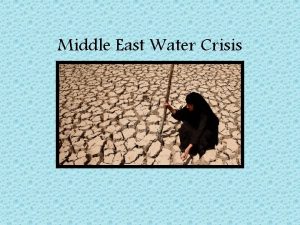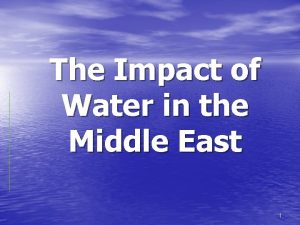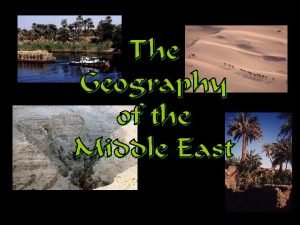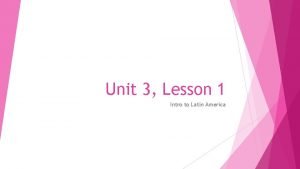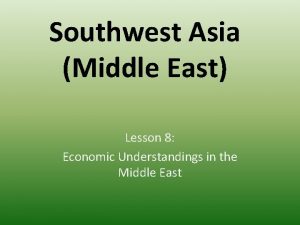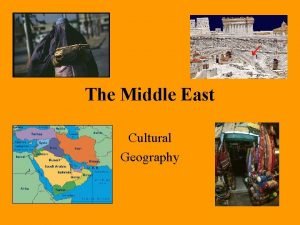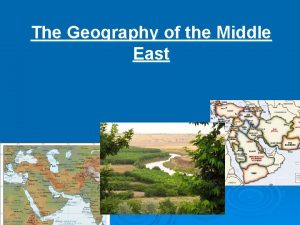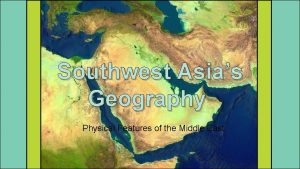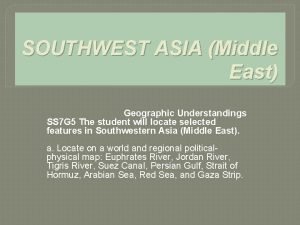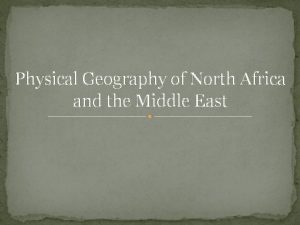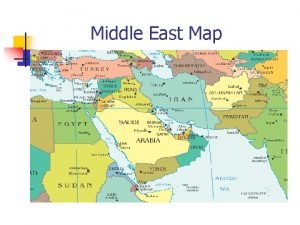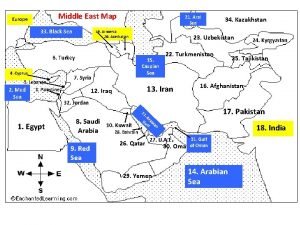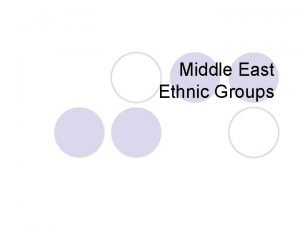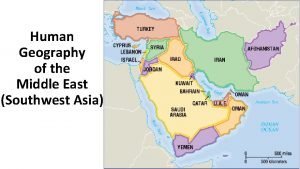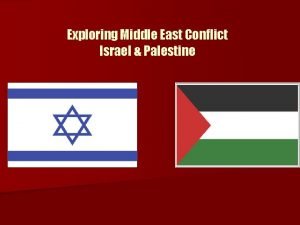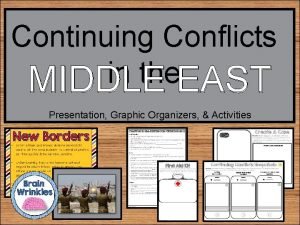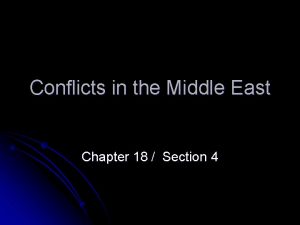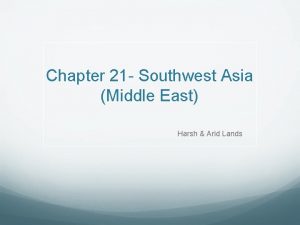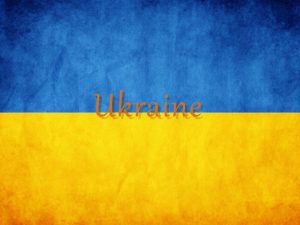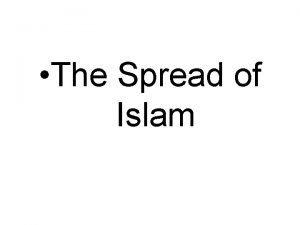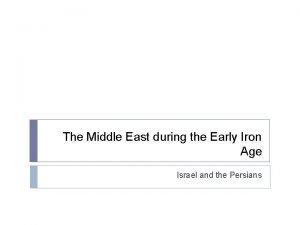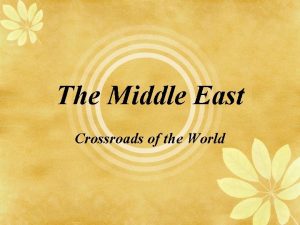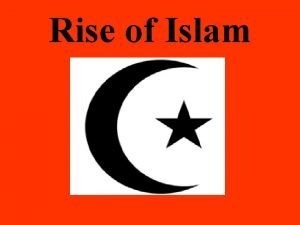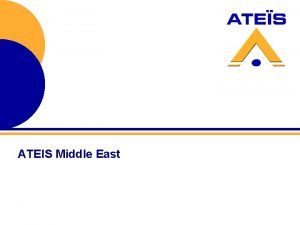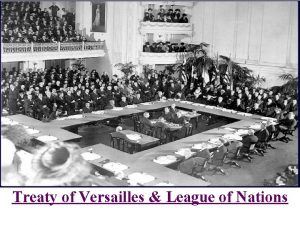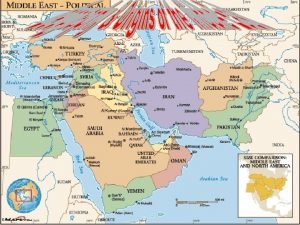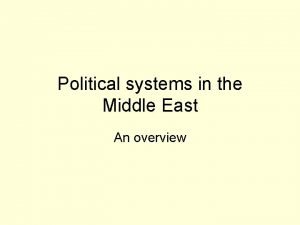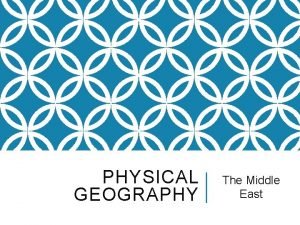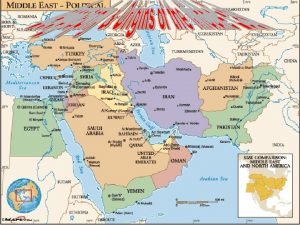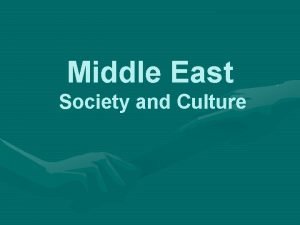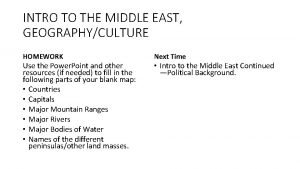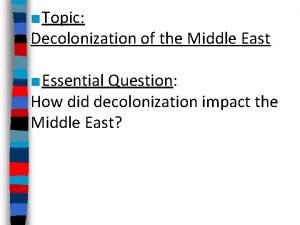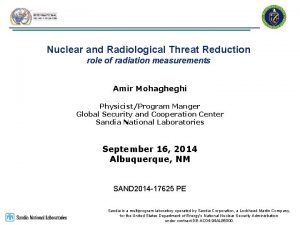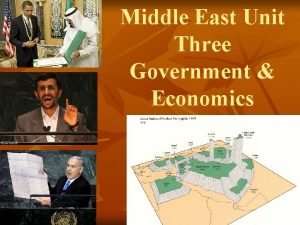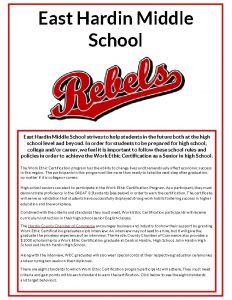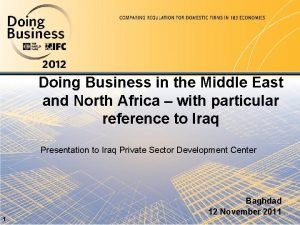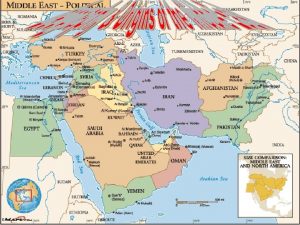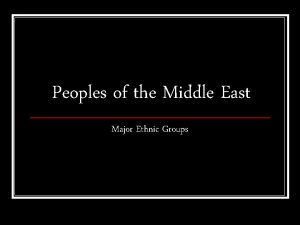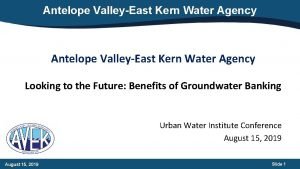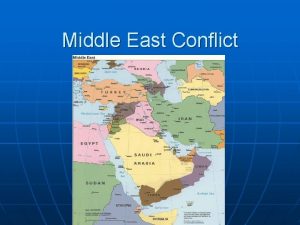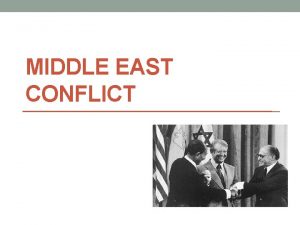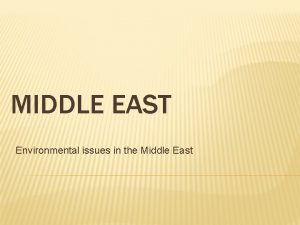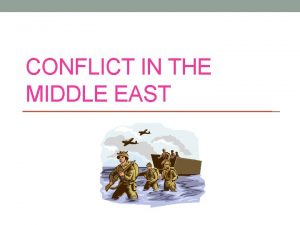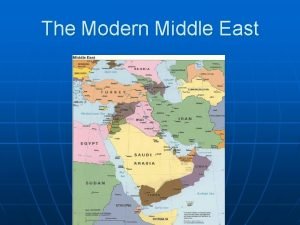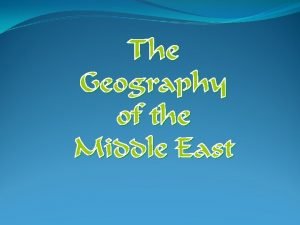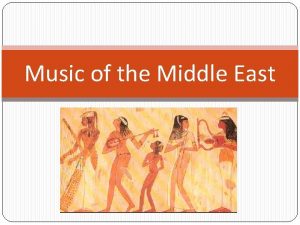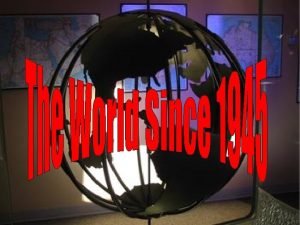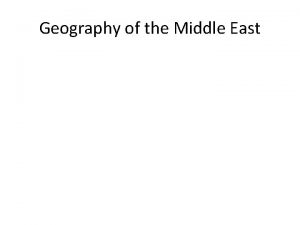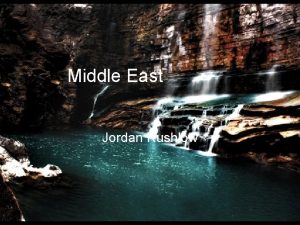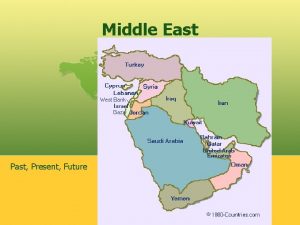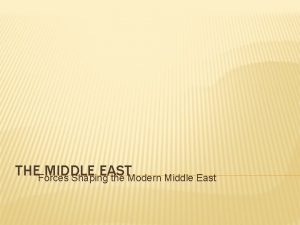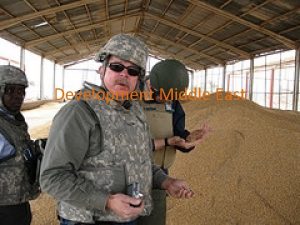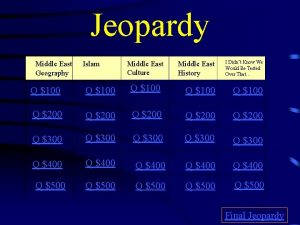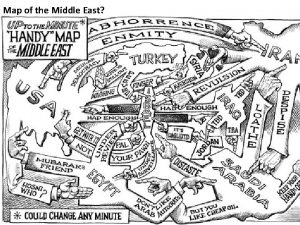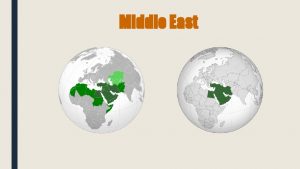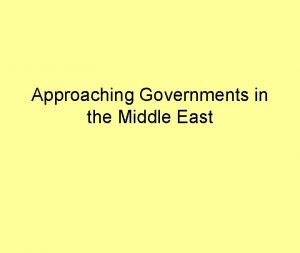Water Issues and Conflict in the Middle East





























































- Slides: 61

Water Issues and Conflict in the Middle East If we solve every other problem in the Middle East but do not satisfactorily resolve the water problem, our region will explode. ” (Yitzhak Rabin in Klare 2001: 141) “

Water and War n n “The next war in the Middle East will be over water, not politics. ” (Boutros. Ghali, Secretary General, United Nations) “The only matter that could take Egypt to war again is water. ” (Anwar Sadat, President of Egypt) “Water is the one issue that could drive nations of the region to war. ” (King Hussein, Jordan) “Many of the wars in this century were about oil, but wars of the next century will be about water. ”(Ismail Serageldin, Vice President, World Bank)

Water and Conflict n Water is not distributed uniformly around the globe, and has been a sourc of tension wherever water resources ar shared by neighboring peoples. n Globally, there are more than 250 wate bodies shared by more than one countr

Current Water Situation in Middle East Region

WATER - A RENEWABLE OR FINITE RESOURCE? • Water is critical for life, food production, and industrial processes. • 9 out of 14 Southwest Asian states face water-short conditions (the most concentrated region of scarcity in the world).

Water Supply Southwest Asian countries often get into disputes over their policies on water rights and other natural resources. n Water rights are agreements about how countries can use the water in a region. n Water rights often cause political disputes. n

Facts about water and water scarcity in the ME n n n According to the World Bank the amount one human needs in order to remain alive and healthy is 100 to 200 litres per day ! Less than 3 percent of world’s overall water is fresh water, less than 1 percent of the fresh water supply is accessible to humans. World Bank: Eleven countries in the ME have annual per capita supplies at or less than 100 cubic meters: n Algeria, Egypt, Israel, Jordan, Libya, Morocco, Saudi Arabia, Syria, Tunisia, the United Arab Emirates and Yemen

Water Issues in the Middle East WATER Only 3 countries in the Middle East do not need to depend on outside fresh water: Iran, Egypt, and Turkey 2/3 of the Middle East depend on water from outside their borders Jordan is one of the most water scarce countries in the world. One of the 504 dams in Turkey

Water Issues in the Middle East: • >90% of population growth will be in developing countries where clean water supplies are low. • Nine countries in the Middle East use >100% of their renewable water supply (depleting groundwater). • Egypt depends entirely on the Nile to irrigate crops. Ethopia controls 80% of Nile’s flow upstream and plans to divert water for itself. Could be catastrophic for Egypt.

Water Situation • Saudi Arabia, have almost no water. • They are mostly made up of desert. • Iran has areas with access to rivers and areas that are made up of deserts. • Because water is in short supply in so many parts of Southwest Asia, irrigation has been necessary for those who want to farm and raise animals for market. • People must live where there is water.

North Africa / Middle East, Mean Annual Precipitation (mm) Saha ra

Fresh Groundwater Sources

Water Pollution

Pollution The process of refining oil also creates pollution. n Refining oil means making oil from the ground ready to use in machines. n Refining oil produces toxic chemicals. n This is an enormous problem for the environment in the Southwest Asia. n

Water Pollution in the Middle East There are many serious environmental problems in the Middle East. n The water supply is very limited and finding fresh water for farming or drinking is a struggle throughout the region. n Israel has very few fresh water sources and the Sea of Galilee provides its primary supply of drinking water. n

Water Pollution in the Middle East n n n Water pollution caused by oil spills from drilling, refineries and shipping sometimes leak into rivers and water supplies. This impact irrigation and drinking water because it causes health hazards. Some countries are adjusting/adapting to the limited amount of water resources available by building desalination facilities to remove salt from salt water.

Examples of Conflicts over Water in the Middle East Overview

Water Conflicts of the Middle East in the Past n Destruction of Babylonian irrigation systems as retribution by Assyrians n n Modern period: Fashoda Crisis in southern Sudan in 1898 between France an Britain Water conflicts during Cold War o Arab-Israeli War of 1967 (control over river Jordan) o Syria and Iraq almost went to war in 1975 (Syria filled up Lake Assad, and reduced flow of Euphrates River) o 1990 Turkey blocked flow of Euphrates to fill up its own reservoirs

Hydropolitics and Geopolitics Political negotiations centred on conflicts over the shared use of water sources History of hydropolitics in Nile Basin • tensions due to the dominance of Egypt • civil wars in Sudan Ethiopia • tensions from Egypt’s treaties dating back to the 1929 and 1959 Nile Water Agreements. • Upstream states increasingly challenging Egypt’s dominance. • Ethiopia wants to use the Nile River for HEP plants and industrial development. Tech Fix ; The megaprojects of dams like Aswan are famous. Latest high tech is the 1990 sproject called ‘Tecconile’ a joint GIS system to help monitor and plan the basin • The Nile is the world’s longest river , 6, 500 kms, 2. 9 km 2 catchment, 10% of Africa, running through 10 countries with 360 million people depending on it for survival. • Growing issues of desertification & salination and increased evaporation linked to climate change • About 85 % water originates from Eritrea and Ethiopia, but 94 % is used by Sudan and Egypt. Evidence of more effective co-operation • The Nile Basin Initiative, system of cooperative management which started late 1990 s • All countries except Eritrea working with The World Bank and bi-lateral aid donors. • Community level involvement. • Managers visited Colorado River recently to see how effectively the 1922 River Water Compact and its ‘law of the river’ works • • 1996 Helsinki Rules on the Uses of the Waters of International Rivers - regulating how transboundary rivers and groundwater are managed The Nile Basin is an example that ‘Water Wars’ may be averted

In the Northern region: Turkey is in dispute with Syria and Iraq over damming more of the Tigris and Euphrates river In the Western Region: Israelis, Syrians, Jordanians and Lebanese are all in dispute over shrinking water supplies A contributory factor to the 1967 Arab. Israeli war Water storage is in 3 huge aquifers under the Israeli mountains and coastal strip and the R Jordan Water Issues in the Middle East The Aral Sea, on the boundary of the Middle East and Asia is suffering from over abstraction and pollution • • There are significant disputes over access to water already in this area The combination of a growing population and low seasonal rainfall are the main causes. Is the energy dependent technological fix of desalination the answer? Photo of a plant in Dubai

Conflict over the Tigris and Euphrates River

Euphrates River • The Euphrates River flows through Turkey, Syria, and Iraq. • These countries all rely on the Euphrates for farming and for electricity. • The river begins in Turkey and flows to the Persian Gulf. • Turkey built two dams on the Euphrates in 1984 to harness its power for electricity.

Conflict over the Tigris and Euphrates Rivers • The Euphrates and Tigris provides water for much of Syria and Iraq however, they begin in Turkey has been trying to build hydroelectric dams which would reduce the water supply to the other 2 countries. Syria built its own dams in response cutting off even more water to Iraq.

Dam Buiding • These dams make the river less powerful. Syria also built a dam on the Euphrates. • By the time the river reaches Iraq, it is much smaller and less powerful than it was originally. • Water supply in Iraq is also diminished and farming is very difficult. • In 1975, a war almost broke out between Syria and Iraq over water rights.

• Fresh water supplies are available only in small amounts • Dams are very controversial in this region as they affect multiple countries at once.

Water Conflict between Israel and Jordan

Conflict Between Israel and Jordan over Water Supplies • The Jordan River is the major source of water for both Israel and Jordan • Early 1950 s: Israel wanted to cultivate additional desert land -> built a new pipeline to bring water from the Jordan River to the Negev Desert • Called the National Water Carrier, an integrated network of pumping stations, reservoirs, canals and pipelines • Pipelines became the central water supply for Israel but pipeline was a threat to Jordan’s water supply Nancy Tay

Conflict Between Israel and Jordan over Water Supplies • Downstream users in Jordan could not get the water they needed • Border clashes between Jordan and Israel • 1967 Israeli – Jordanian War • Israel won and occupied the Golan Heights Israel also – Gained complete control of the Upper Jordan River – Jordan could not tap as much water from the Jordan River – Critical shortage of water in Jordan Nancy Tay

Conflict Between Israel and Jordan over Water Supplies Israel also • Destroyed a dam Jordan was constructing on the Yarmouk River during the war • Diverted large amounts of water from the Yarmouk River into Lake Tiberias • Obstructed all attempts by Jordan to build a water storage system to improve its water supply Nancy Tay

Conflict Between Israel and Jordan over Water Supplies Golan Heights Yarmouk River Lake Tiberias Nancy Tay

Conflict Between Israel and Jordan over Water Supplies Steps Taken and Results • Jordan and Israel signed a peace treaty – Both agree to share the Jordan River and provide each other with water – Both agree to build dams and create storage facilities to hold excess rainwater Nancy Tay

Water Issues Between the Israelis and Palestinians



Israel, Jordan, and the Palestinians • Israel, Jordan, and the Palestinians on the West Bank, all depend on many of the same scarce water resources. • Israel has the most power, so it has been most effective in claiming water. • Much Israeli water is also cleaned after it is used once, and is then reused. • Ways have to be found to make sure that everyone has access to enough water.

Equitable Distribution 1. River Jordan (Israel 100%; Palestine 0%) 2. Coastal Aquifer (Israel 82%; Palestine 18%) 3. Mountain Aquifer (Israel 83%; Palestine 17%) 4. Other Sources (Israel 100%; Palestine 0%) Per capita consumption (1994) Israelis Palestinians Israelis consume (4 x more) per head 344 m 3/yr 93 m 3/yr

Water for Palestinian Israelis • In Israel itself 90, 000 Palestinian Israeli citizens live in unrecognised villages. • Although these villages often predate the establishment of the state of Israel, Israel refuses to recognise their existence and consequently denies them all municipal services – water, electricity, health care, education, etc. • In addition the land they are built on is zoned for Jewish only settlement so their homes are subject to demolition.

Permits for Wells In 1967 - 140 Palestinian wells were destroyed. As 227, 500 Palestinians have no access to piped water and a further 190, 000 have only limited access (B’Tselem) wells are frequently vital for communities survival. Permits for new wells can go through up to 18 stages of approval. A permit is required to use your own well. Having a permit to use your well does not assure access to it Between 1967 and 1996 a total of 13 permits were given to Palestinians. All were for domestic use only, not a single agricultural well! "A pattern starts to emerge where it appears that the Israelis are deliberately trying to sabotage Palestinian efforts to both access and fully develop their water resources, “ (Oxfam).

Permits: Wastewater More than 90 % of all West Bank wastewater is untreated, only 1 plant is operating. Only one in five Palestinian families in West Bank are connected to sewage systems. 69 % use outdated septic tanks (often prohibitively expensive to maintain and empty). Several construction permits are required to build a new tank. The German government has repeatedly offered to build fully funded sewage treatment facilities in the West Bank, only for Israel to block their proposal. “Palestine’s capacity to treat wastewater has been systematically retarded by Israel, ” (The World Bank).

West Bank Barrier and Water Issues

West Bank Water Pollution 91 mcm of wastewater is discharged annually into the West Bank, 38% from Israeli sources. Jerusalem pipes half of its 35 mcm to the east, creating the raw sewage nightmare of Wadi Kadrun. 40 settlements east of the Green Line are not connected to any waste water facility. Others do not function and spill excrement onto the Palestinian villages below them. “There is no real life there - it is just waste water, ” Iyad Aburdeieneh, Palestinian Deputy Director of Friends of the Earth Middle East.

Settler Water Use Settlers consume 10 % of all West Bank water; 95% of settler use is agricultural. Palestinian private and domestic use totals 63 m 3/yr. Recent figures suggest settlers use could be as much as 800 m 3/yr.

West Bank Settlements All settlements are illegal under International Humanitarian Law. Settlements are generally built on hills close to or upon the best wells and water supply. Lands settlements are built upon are ‘re-designated’ as state lands allowing for new wells to be drilled. The impenetrable permit system only applies to Palestinians.

West Bank Aquifer aka Mountain Aquifer WESTERN BASIN • largest and most abundant • lies in Israel and part of West Bank but it is recharged by precipitation that falls in West Bank • historically used by Palestinians, then with Jewish migration into Palestine at end of 19 th century, water became shared • 1920 s/30 s intensive exploitation of resources by Jewish settlers which was then promoted further by Israel between 1948 and 1967 • This continued after Six Days War and now more than 90% of basin used by Israel

West Bank Aquifer NORTH-EASTERN BASIN • Also considered to be transboundary EASTERN BASIN • Lies entirely within the West Bank • Used exclusively by Palestinian farmers and villagers until 1967

Mountain Aquifer Water Use Israelis Palestinians Illegal Israeli settlers 73% 17% 10% The daily per capita consumption in Israel is 242 liters in urban areas and 211 liters in rural communities (in 2007). By comparison, the consumption in the West Bank is 73 liters person (in 2008). In certain districts, consumption was as low as 37 liters (Tubas District), 44 (Jenin District), and 56 (Hebron District). (B’Tselem (2010). According to the Palestinian Hydrology Group, (2003) 7% of communities subsist on 30 litres/day or less and 36% of communities subsist on between 30 and 50 litres/day. The World Health Organisation recommended minimum is 100 litres/day Similarly in Israel around 95% of irrigable land is irrigated. In the West Bank the figure is only 25 -33%. (Philip Mattar: Encyclopedia of the Palestinians).

West Bank Aquifer • Hydrological matters additional dimension to conflict • Water resources often coincide with disputed land are transboundary in nature e. g Israel receives more than 50% its water from Arab territories • Emerged mainly since 1960 s • After 1967 war (water one of issues to initiate war) Israeli policies and institutions extended to occupied territories

West Bank Aquifer • Now, Israel using nearly 80% of West Bank waters. • Palestinian plight further compounded by fact they are forced to pay higher rates for their water supply • Huge discrepancies between water allocated to Palestinians and Israelis • Also further tension due to Palestine’s claims to share of Jordan river

West Bank Aquifer • Water needed for domestic use but also vital for agriculture • 80% of water resources assigned to irrigation of crops in Israel and West Bank • Agriculture represents 25% of Palestinian GDP. • In Israel agriculture is 4% BUT per capita, Israel uses 4 times more water than Palestine annually

Water, Land Confiscation and the Wall 80% of the illegal wall is built on Palestinian Land; so far 25 wells and cisterns and 35, 000 meters of water pipes have been destroyed and many more wells and 200 cisterns have been isolated from their owners. The Wall will also put much of the Western Aquifer and on the Israeli side. In addition around 45% of the West Bank is designated as closed military zones, state lands or nature reserves. These lands often correlate with the major water resources and thereby put these reserves beyond use for Palestinians.

Water and the Wall • Dr Alan Mac. Donald – British Geological Survey

Water and the Wall A 1999 study examining the economic viability of drilling in the West Bank found that the most productive sites were along the 1949 armistice line. It reported: 1. Groundwater development from both the Upper and Lower Aquifers is most economical in a narrow zone around the 1949 Armistice Line in the northern part of the West Bank. Costs significantly increase with distance from the Armistice Line. This is a fact not lost on those developing the aquifer—this is where most of the operational boreholes are located 2. There areas of the Upper Aquifer that cannot be properly developed. In fact, only a small area around Qalqilya and Tulkarem can be developed economically. Any slight eastern migration of the Palestinian border will have a serious effect on the ability of the Palestinians to develop this aquifer. The separation wall, which is being built to the east of the Armistice Line in Palestinian territory, will therefore significantly reduce the ability of the Palestinians to develop groundwater resources in the Western Aquifer Basin 3. Pumping costs significantly increase with distance from the Armistice Line, (Calow et al. 2003).

The Wall and Drainage The wall deeply affects the hydrology of the watersheds, representing a barrier to the storm water causing serious flooding in adjacent villages. In some locations the wall blocks the passage of sewage along traditional drainage channels. The backed up sewage can flood homes, shops or lands. In Qalqilya following heavy rains in 2005 Israeli soldiers refused to open drainage pipes. The area flooded damaging a poultry farm, several houses and a girls’ elementary school.

Attempted Agreements in Palestinian. Israeli Water Conflict • Johnston Plan 1953 • The signing of the Declaration of Principles September 1993 • Israeli-Jordanian Peace Treaty of October 1994 • Oslo Accords

Gaza Strip Water Issues

The Coastal Aquifer: Gaza The Coastal Aquifer is Gaza’s only water supply. Water consumption is 140 litres person per day. The coastal aquifer is over-exploited and is becoming contaminated by sea water and raw sewage. According to Amnesty International the water situation in Gaza has reached “crisis point” with between 90 and 95% of water unfit for human consumption. UN scientists estimate that within 15 years Gaza will have no drinkable water.

Gaza: Water and Health The Palestinian Water Authority estimates that almost 40% of the incidence of disease in Gaza is related to polluted drinking water. According to international NGOs 20% of Gazan families have at least one child under five who suffers from diarrhoea as a result of polluted water. B'Tselem reports: "A UN study published in 2009 estimates that diarrhea is the cause of 12% of children's deaths in Gaza. The lack of potable drinking water is liable to cause malnutrition in children and affect their physical and cognitive development. “ In 2007 current Israeli Prime Minister Netanyahu suggested that Israel could cut off all water to Gaza.

Gaza War Damage The 2009 Damage Assessment Report, CMWU speaks of $5. 97 million damage to Gaza’s water and wastewater treatment facilities and infrastructure. In central Gaza the largest wastewater treatment plant in the Gaza Strip was shelled causing pipelines to rupture and raw sewage to flood more than a square kilometre of agricultural and residential land. Much of the damage was to pipelines torn up by Israeli tanks and bulldozers. Pipes are among the items Israeli authorities bar from entering Gaza. Palestinian Government sources say that more than 800 of Gaza’s 2, 000 water wells were destroyed or rendered un-useable.

Gaza and the Siege "Since the beginning of the siege Israel has prohibited the entry of equipment and materials that can be used to improve water quality and taste, and to develop and rehabilitate the water infrastructure and the wastewater treatment facilities in Gaza… The equipment needed includes water pumps, pipes, generators, computers, building cement and chloride, ” B’Tselem. In 2007 sewage deluged northern Gaza when the treatment facility was shelled – 5 drowned. More than two-thirds of Gaza's 4, 000 agricultural water wells rely on fuel powered pumps and shortages of fuel are leaving crops to die.

Conclusions • Issues of quantity, quality and distribution • Water important factor in conflict in region and as demand outweighs supply, multi-lateral agreements are only way forward • Water scarcity increasing year by year due to population growth, over-exploitation and pollution • Although water scarcity and distribution causes conflict, maybe, the severity of the water crisis could breed cooperation between Palestine and Israel?

Resolving the water conflict will not bring peace to the region. However, peace is not attainable without a solution to the water conflict
 Water and water and water water
Water and water and water water North american
North american Gope
Gope Water pollution in the middle east
Water pollution in the middle east East is east and west is west
East is east and west is west Horizontal movement of air
Horizontal movement of air Middle east natural resources
Middle east natural resources Lesson 1 physical geography of south america
Lesson 1 physical geography of south america Lesson 8 middle east and south asia
Lesson 8 middle east and south asia Nationalism in africa and the middle east
Nationalism in africa and the middle east You love going to soccer practice every friday night
You love going to soccer practice every friday night What is conflict and conflict resolution?
What is conflict and conflict resolution? External conflict definition
External conflict definition Cultural geography of the middle east
Cultural geography of the middle east Why is it called the middle east
Why is it called the middle east Inlet of indian ocean between africa and asia
Inlet of indian ocean between africa and asia Jordan river on map
Jordan river on map Physical geography of north africa
Physical geography of north africa Middle east map
Middle east map Black sea on middle east map
Black sea on middle east map Ethnic groups in the middle east
Ethnic groups in the middle east Southwest asia geography
Southwest asia geography Middle east war
Middle east war Gosforth east middle school
Gosforth east middle school Conflicts in the middle east comprehension check
Conflicts in the middle east comprehension check Chapter 18 section 4 conflicts in the middle east
Chapter 18 section 4 conflicts in the middle east Chapter 21 section 2 climate and vegetation
Chapter 21 section 2 climate and vegetation Biotime 7.0 software free download
Biotime 7.0 software free download Is ukraine middle east
Is ukraine middle east Middle east before islam
Middle east before islam Iron age middle east
Iron age middle east Crossroads of the world middle east
Crossroads of the world middle east Middle east before islam
Middle east before islam Ateis magellan
Ateis magellan Treaty of versailles middle east
Treaty of versailles middle east 3 peninsulas in middle east
3 peninsulas in middle east Middle east political system
Middle east political system Physical geography of middle east
Physical geography of middle east Middle east background
Middle east background Three peninsulas in the middle east
Three peninsulas in the middle east Millet system
Millet system Literacy rates in the middle east are __________.
Literacy rates in the middle east are __________. Decolonization in the middle east
Decolonization in the middle east Middle east language map
Middle east language map Coweta middle school
Coweta middle school Map of the middle east countries
Map of the middle east countries Map of middle east
Map of middle east Middle eastern geography
Middle eastern geography East hardin middle school
East hardin middle school Doing business 2012
Doing business 2012 What three peninsulas are in the middle east
What three peninsulas are in the middle east What are the major ethnic groups in the middle east
What are the major ethnic groups in the middle east Antelope valley east kern water agency
Antelope valley east kern water agency Hình ảnh bộ gõ cơ thể búng tay
Hình ảnh bộ gõ cơ thể búng tay Lp html
Lp html Bổ thể
Bổ thể Tỉ lệ cơ thể trẻ em
Tỉ lệ cơ thể trẻ em Chó sói
Chó sói Glasgow thang điểm
Glasgow thang điểm Chúa yêu trần thế
Chúa yêu trần thế Các môn thể thao bắt đầu bằng tiếng nhảy
Các môn thể thao bắt đầu bằng tiếng nhảy Thế nào là hệ số cao nhất
Thế nào là hệ số cao nhất


